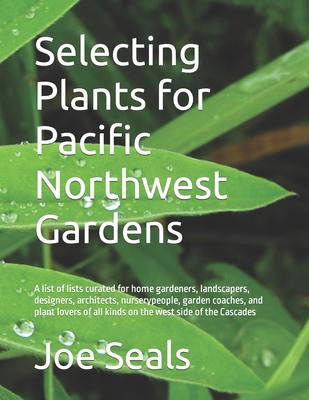This list of lists provides a methodology for finding the best plant for the place. This is the concept of "right plant, right place." The most successful garden or landscape is based on the process of defining the environment (the "place") first and then finding the "plant" or "plants" which fit that defined environment. It also points out the great wealth of plant material which we PNW'ers can use in our gardens and landscapes.
The book organizes thousands of plants into general categories such as Native Plants for garden use, Basic Types (tree, shrub, perennial, etc.), Environmental Needs (sun/shade, soil type), Bloom Time, Resistances to Pests and other Problems, Ornamental Features, Design Style, and many other decision-influencing categories. It finishes with more than one hundred mail-order sources of plants, bulbs, and seeds.
A small sampling of the more than 125 lists within these broader categories:
- Choice Native Perennials
- PNW Natives for a Rock Garden
- Small to Medium Flowering Trees
- Trees for Screening/Background
- Disease-Resistant Roses
- Fall-Planted, Spring-Blooming Bulbs
- Hardy Succulent Plants (Including Cacti)
- Seeds to Scatter Sow in Fall
- Plants for Clay/Heavy Soil
- Between Pavers, Flagstone, Stepping Stones
- Late Summer into Fall Bloomers
- Slopes & Erosion Management
- Hell Strip
- Slug & Snail Resistant Plants
- Pet-Toxic Plants
- Attracting Birds, Bees, Butterflies, and Hummingbirds
- Container Plants
- Cutflowers
- The Small Garden
- A Children's Garden
- The Flower Border - By Color
- Colorful Foliage
- Weeping Trees
- Fragrant Flowers
- An English Cottage-Style Garden
- "Ornamedibles"
- Mail-Order Plant Companies
Altogether, these lists comprise several thousand different kinds of plants, emphasizing the great wealth of plant material which PNWers can use in gardens and landscapes. Sorry, no photos. This book's system of selecting plants emphasizes a focus on environmental conditions or other selection factors. This results in the most successful garden and landscape. It does require follow up research including a look at photos, of course, to determine the best match to the gardener's liking. To help, the book includes a section on "How to Find More information Along with Plant Photos on the Internet." A book with photos, on the other hand, would either be too big or would need to be edited to but a few selected plants. Such a book would require follow-up research to determine exact match to environment, as well. "Selecting Plants for Pacific Northwest Gardens" is the ultimate guide to making appropriate plant choices and will prove to be an indispensable reference for every amateur gardener, landscape designer, and horticultural professional.
